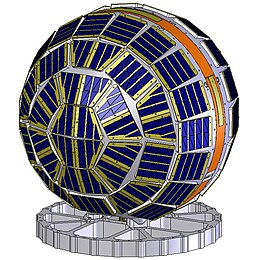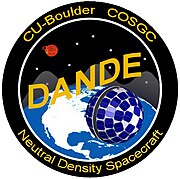This article needs additional citations for verification. (September 2013) |
 The DANDE satellite in its launch configuration. | |
| Mission type | Technology |
|---|---|
| Operator | University of Colorado Boulder Colorado Space Grant Consortium CU Dept of Aerospace Engineering Sciences AFRL STP |
| COSPAR ID | 2013-055C |
| SATCAT no. | 39267 |
| Website | spacegrant |
| Mission duration | 1.5 years |
| Spacecraft properties | |
| Launch mass | 50 kilograms (110 lb) |
| Dry mass | 38 kilograms (84 lb) |
| Start of mission | |
| Launch date | 29 September 2013, 16:00:13 UTC[1] |
| Rocket | Falcon 9 v1.1[2] |
| Launch site | Vandenberg SLC-4E |
| Contractor | SpaceX |
| End of mission | |
| Last contact | c. 8 February 2014[3] |
| Orbital parameters | |
| Reference system | Geocentric |
| Regime | Low Earth |
| Perigee altitude | 331 kilometres (206 mi)[4] |
| Apogee altitude | 1,426 kilometres (886 mi)[4] |
| Inclination | 80.99 degrees[4] |
| Period | 102.310 minutes[4] |
| Epoch | 24 January 2015, 03:43:37 UTC[4] |
| Instruments | |
| Neutral Mass Spectrometer and Accelerometer | |

| |
DANDE (or Drag and Atmospheric Neutral Density Explorer) is a 50 kg class spacecraft developed by the University of Colorado Boulder was the winner of the 5th iteration of the Air Force Research Laboratory's University Nanosat Program.[5]
Due to a failure in a spacecraft system, the ground team was unable to actively command the satellite and spacecraft became just a passive object in Earth orbit by which some passive drag characteristics might be deduced.
- ^ McDowell, Jonathan. "Launch Log". Jonathan's Space Page. Retrieved 25 May 2014.
- ^ "Falcon rocket debut delayed". 13 September 2013.
- ^ "As of Feb 8th..." Twitter.com. 4 June 2014. Retrieved 4 September 2020.
- ^ a b c d e "DANDE Satellite details 2013-055C NORAD 39267". N2YO. 24 January 2015. Retrieved 25 January 2015.
- ^ "CU-Boulder Students Win First Place in National Nanosatellite Competition". University of Colorado Boulder. 22 January 2009.